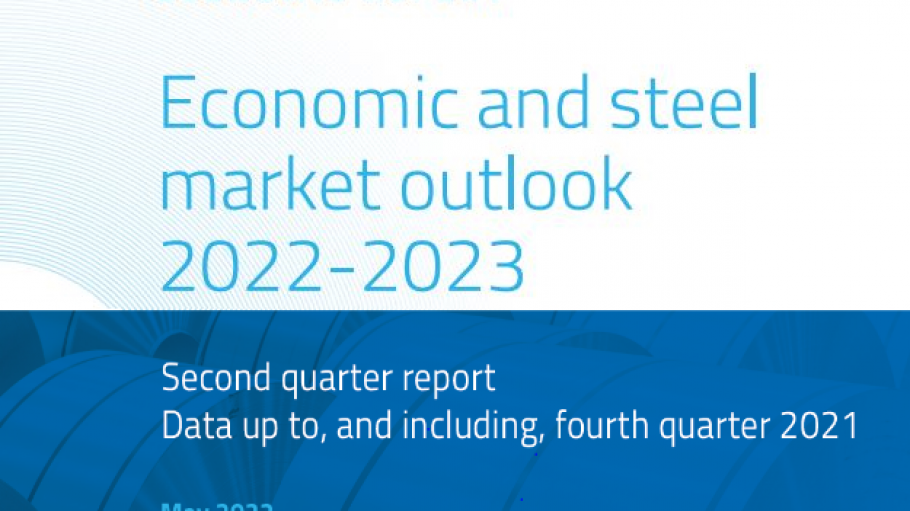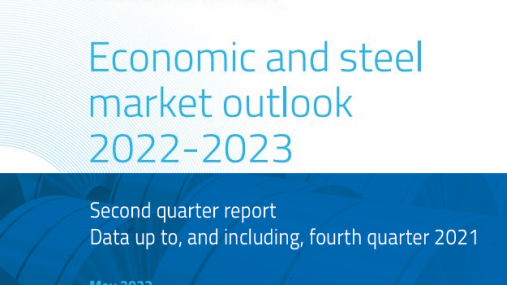
Publications » Economic and market outlook » Economic and steel market outlook 2022-2023, second quarter
Economic and steel market outlook 2022-2023, second quarter
Downloads and links
Recent updates

The positive trend in apparent steel consumption as well as in steel demand seen over the first three quarters of 2021 continued also in the fourth quarter, albeit at a considerably slower pace, while 2022 is expected to be subject to significant disruptions and uncertainties. Ongoing global issues have cast uncertainty on the economic and industrial outlook since last summer, and this situation is likely to last at least until the end of this year. Russia’s invasion of Ukraine in February 2022 and its wide repercussions on oil and gas prices, global trade and supply chains in general have considerably worsened the picture.
Economic recovery in the EU appears to be increasingly uneven and exposed to downside risks: shortage of components and raw materials, skyrocketing energy prices, rising shipping costs, etc. have already resulted in slashed GDP growth prospects for 2022. Recovery in steel-using industries and in steel demand is expected to continue - after the strong rebound seen in 2021 following the COVID-led slump in 2020 - but at a very moderate rate. High uncertainty is set to last at least until the end of 2022, conditional upon developments in the Russia-Ukraine war – which remain unpredictable at the time of writing – and its consequences on global supply chains.
In the fourth quarter of 2021 EU apparent steel consumption increased for the fifth consecutive time in a row (+9.5%), albeit at a lower rate than in the third quarter (+14.3%) due to the impact of severe supply chain issues and rising energy prices. Apparent steel consumption amounted to 36.3 million tonnes (35.9 million tonnes in the third quarter).
The whole year 2020 was considerably impacted by the COVID-19 pandemic and saw apparent steel consumption in the EU plummet (-10.7%, almost unchanged compared to the previous Outlook) for the second consecutive year after the slump (-5.2%) already seen in 2019. In 2021 apparent steel consumption rebounded (+15.2 %, revised upwards from +13.8% in the previous Outlook) after the deep recession (-10.7%) experienced in 2020 caused by the pandemic. However, ongoing supply chain issues and the war in Ukraine are set to take their toll on apparent steel consumption: in 2022 it is expected to see its third annual recession over the last four years, albeit moderate (-1.9%), as a result of quarterly drops forecast in the second and the third quarters of 2022. Apparent consumption is set to recover in 2023 (+5.1%), but the overall evolution of steel demand remains subject to a high level of uncertainty, which is likely to continue to undermine demand from steel-using sectors.
Domestic deliveries also recorded growth in volumes over the fourth quarter of 2021, albeit very modest (+0.6%, after +6.5% in the third quarter), reflecting the slowdown in demand within the EU over the second half of 2021. Over the entire 2021, deliveries sharply rebounded (+10.7%), following the pronounced drop of 2020 (-9.6%) which marked the second consecutive decline in yearly terms after 2019 (-4.2%).
Imports – including semi-finished products – into the EU continued their dramatic surge also over the fourth quarter of 2021 (+43%, after +48% and +45% in the third and second quarter respectively). With the exception of the second quarter figure reflecting the comparison with the heavy impact of the pandemic the year before, import penetration has therefore remained considerably high.
As a result, in 2021 imports from third countries significantly rose (+32%) after two consecutive drops (-17.1% in 2020 and -10.9% in 2019), mirroring the improvement in steel demand.
EU steel-using sectors
After the record lows of 2020 due to lockdown measures, in 2021 steel-using industries in the EU experienced a strong rebound in output, which peaked in the second quarter (+26.3%). A faster-than-expected recovery in some sectors (domestic appliances and automotive in particular) facilitated recovery from the losses experienced due to the pandemic over the first half of 2021. However, major issues along the global supply chain experienced since July 2021, especially affecting the automotive sector (rising transportation, energy and shipping costs, shortage of components, etc.), have impacted output over the third and the fourth quarter. As a result, total steel-using sectors’ output recorded a meagre increase (+0.7%), after a rise (+2.2%) in the third quarter. In particular, the automotive sector saw output plunge for the second consecutive quarter (-14.6% after -15.2%), reflecting increasingly severe disruptions along the supply chain as well as subdued demand from consumers.
Total steel-using sectors’ output is expected to continue to increase in 2022, but its growth rate will be halved compared to EUROFER’s previous outlook (+2% versus +4% previously foreseen). This results from the rapid deterioration of the global industrial and economic outlook due to the war in Ukraine, coupled with ongoing and worsening supply chain issues. This situation has cast wide uncertainty on the steel-using industries’ outlook, at least until the end of 2022. As a result, growth in output is expected to gain only modest ground in 2023 (+2.3%).

Download this publication or visit associated links
Brussels, 02 July 2025 – The 90% climate target proposed today by the European Commission demands an unprecedented transformation of EU society and industry in just 15 years. The European steel industry is already doing its part, but a viable business case for the transition is still lacking. To enable it, the EU needs to implement the Steel and Metals Action Plan much more decisively, delivering a highly effective trade protection against global overcapacity, access to internationally competitive low carbon energy and scrap, and a watertight CBAM, says the European Steel Association.
How global overcapacity is destroying European industries
European Steel in Figures 2025 is EUROFER's statistical handbook, laying out in an easy-to-use format the key statistics and data about the performance and footprint of one of Europe's most important strategic sectors